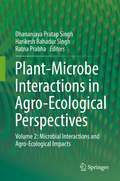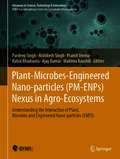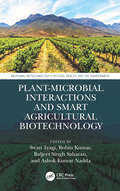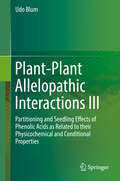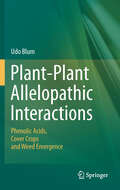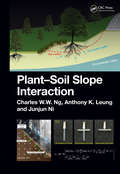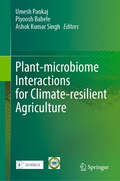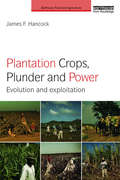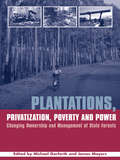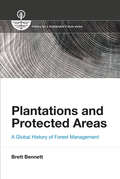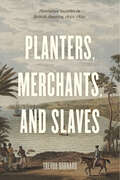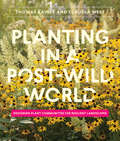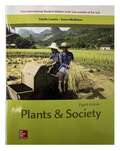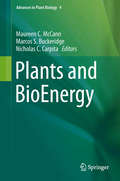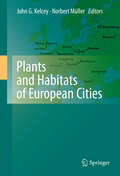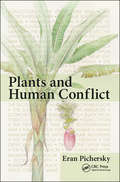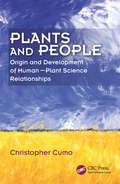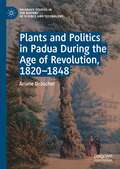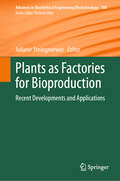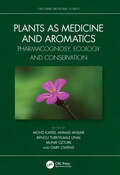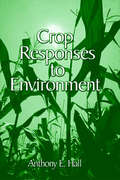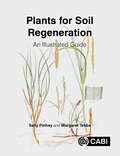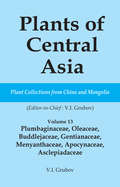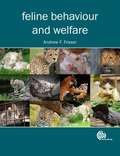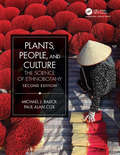- Table View
- List View
Plant-Microbe Interactions in Agro-Ecological Perspectives
by Harikesh Bahadur Singh Dhananjaya Pratap Singh Ratna PrabhaThis books presents an updated compilation on fundamental interaction mechanisms of microbial communities with the plant roots and rhizosphere (belowground) and leaves and aerial parts (aboveground). Plant rhizopshere recruits its own microbial composition that survive there and help plants grow and develop better under biotic and abiotic conditions. Similar is the case with the beneficial microorganisms which are applied as inoculants with characteristic functions. The mechanism of plant-microbe interactions is interesting phenomenon in biological perspectives with numerous implications in the fields. The First volume focuses on the basic and fundamental mechanisms that have been worked out by the scientific communities taking into account different plant-microbe systems. This includes methods that decipher mechanisms at cellular, physiological, biochemical and molecular levels and the functions that are the final outcome of any beneficial or non-beneficial interactions in crop plants and microbes. Recent advances in this research area is covered in different book chapters that reflect the impact of microbial interactions on soil and plant health, dynamics of rhizosphere microbial communities, interaction mechanisms of microbes with multiple functional attributes, microbiome of contrasting crop production systems (organic vs conventional), mechanisms behind symbiotic and pathogenic interactions, endophytic (bacterial and fungal) interaction and benefits, rhizoplane and endosphere associations, signalling cascades and determinants in rhizosphere, quorum sensing in bacteria and impact on interaction, mycorrhizal interaction mechanisms, induced disease resistance and plant immunization, interaction mechanisms that suppress disease and belowground microbial crosstalk with plant rhizosphere. Methods based on multiphasic and multi-omics approaches were discussed in detail by the authors. Content-wise, the book offers an advanced account on various aspects of plant-microbe interactions and valuable implications in agro-ecological perspectives.
Plant-Microbes-Engineered Nano-particles: Understanding the Interaction of Plant, Microbes and Engineered Nano-particles (ENPS) (Advances in Science, Technology & Innovation)
by Ajay Kumar Pardeep Singh Rishikesh Singh Pramit Verma Rahul Bhadouria Mahima KaushikThis book presents a collection of cross-disciplinary research, with contributions addressing all key features of the plant/microbe/ENP nexus in agro-ecosystems. The uptake, transport and transformation of nanoparticles in plants have attracted more and more attention in the past several years. Especially, the impact of Engineered Nanoparticles (ENPs) on bioprocesses; low-, medium- and high-level dose responses in the microbial community of soil; and long-, medium- and short-term exposure responses, particularly microbial nitrogen transformations, are just a few of the aspects involved. Since ENPs are used in many industries, including cosmetics, agriculture, medicine, food technology and waste management, their transport through biogeochemical cycles is an important focus of many studies today.Specifically, ENP–microbe interaction has been analysed with regard to disease treatment for plants; it plays a vital role in disease inhibition by releasing metal ions that act through many pathways – e.g. reactive oxygen species (ROS) generation, DNA transformation and disruption of the cell cycle – to stop cell growth in the pathogen. Due to these properties, ENPs are also used as slow release or delayed release pesticides and fungicides, and as carrier systems for growth-promoting hormones. Despite their multiple uses in various industries, the negative effects of ENPs are still a major concern for the scientific community and consumers alike. For example, their transport to various food chains has been reported to have adverse effects. This raises a degree of doubt concerning a rapidly growing scientific field with major applications in many industries.From a sustainable development perspective and particularly to ensure food security in light of the uncertainty accompanying climate change, it is imperative to address this divergence by focusing on the plant/microbe/ENP nexus.
Plant-Microbial Interactions and Smart Agricultural Biotechnology (Microbial Biotechnology for Food, Health, and the Environment)
by Swati Tyagi, Robin Kumar, Baljeet Singh Saharan, and Ashok Kumar NaddaConsidering the ever-increasing global population and finite arable land, technology and sustainable agricultural practices are required to improve crop yield. This book examines the interaction between plants and microbes and considers the use of advanced techniques such as genetic engineering, revolutionary gene editing technologies, and their applications to understand how plants and microbes help or harm each other at the molecular level. Understanding plant-microbe interactions and related gene editing technologies will provide new possibilities for sustainable agriculture. The book will be extremely useful for researchers working in the fields of plant science, molecular plant biology, plant-microbe interactions, plant engineering technology, agricultural microbiology, and related fields. It will be useful for upper-level students and instructors specifically in the field of biotechnology, microbiology, biochemistry, and agricultural science. Features: Examines the most advanced approaches for genetic engineering of agriculture (CRISPR, TALAN, ZFN, etc.). Discusses the microbiological control of various plant diseases. Explores future perspectives for research in microbiological plant science. Plant-Microbial Interactions and Smart Agricultural Biotechnology will serve as a useful source of cutting-edge information for researchers and innovative professionals, as well as upper-level undergraduate and graduate students taking related agriculture and environmental science courses.
Plant-Plant Allelopathic Interactions III: Partitioning and Seedling Effects of Phenolic Acids as Related to their Physicochemical and Conditional Properties
by Udo BlumThis volume continues the retrospective analyses of Volumes I and II, but goes beyond that in an attempt to understand how phenolic acids are partitioned in seedling-solution and seedling-microbe-soil-sand culture systems and how phenolic acid effects on seedlings may be related to the actual and/or conditional physicochemical properties (e.g., solubility, hydrophobicity, pKa, molecular structure and soil sorption/desorption) of simple phenolic acids. Specifically, it explores the quantitative partitioning (i.e., source-sink relationships) of benzoic and cinnamic acids in cucumber seedling-solution and cucumber seedling-microbe-soil-sand systems and how that partitioning may influence phenolic acid effects on cucumber seedlings. Regressions, correlations and conceptual and hypothetical models are used to achieve these objectives. Cucumber seedlings are used as a surrogate for phenolic acid sensitive herbaceous dicotyledonous weed seedlings. This volume was written specifically for researchers and their students interested in understanding how a range of simple phenolic acids and potentially other putative allelopathic compounds released from living plants and their litter and residues may modify soil chemistry, soil and rhizosphere microbial biology, seedling physiology and seedling growth. In addition, this volume describes the potential relationships, where they may exist, for direct transfer of organic compounds between plants, plant communication and plant-plant allelopathic interactions and addresses the following questions: Can physicochemical properties of phenolic acids be used as tools to help understand the complex behavior of phenolic acids and the ultimate effects of phenolic acids on sensitive seedlings? What insights do laboratory bioassays and the conceptual and hypothetical models of laboratory systems provide us concerning the potential behavior and effects of phenolic acids in field systems? What potential role may phenolic acids play in broadleaf-weed seedling emergence in wheat debris cover crop no-till systems?
Plant-Plant Allelopathic Interactions: Phenolic Acids, Cover Crops and Weed Emergence
by Udo BlumIn an effort to implement conservation measures farmers have used a variety of production methods, including the use of reduced or zero tillage and cover crops. One benefit of these production methods has been early season weed control. The literature suggests that a variety of mechanisms may be involved, among them the allelopathic effects of phenolic acids. This retrospective analysis addresses the following: How likely are phenolic acid concentrations and environmental conditions in wheat no-till cropping systems for the inhibition of annual broadleaf weed emergence? and Do phenolic acids have a dominant role or are they just one component of a larger promoter/modifier/inhibitor complex? The book covers allelopathic plant-plant interactions, laboratory and field experiments, and future research. It uses a journal format, provides justifications for procedures used, if-then hypotheses, and cons and pros so that readers can reach their own conclusions.
Plant-Soil Slope Interaction
by Charles Wang Ng Anthony Leung Junjun NiThis inter-disciplinary book provides the latest advanced knowledge of plant effects on vegetated soil properties such as water retention capability, water permeability function, shear strength, slope hydrology, movements and failure mechanisms, and applies this knowledge to the solution of slope stability problems. It is the first book to cover in detail not only the mechanical effects of root reinforcement but more importantly the hydrological effects of plant transpiration on soil suction, soil shear strength, and water permeability. The book also offers a fundamental understanding of soil-plant-water interaction. Analytical equations are provided for predicting the combined hydrological and mechanical effects of plant roots on slope stability. A novel method is also given for simulating transpiration-induced suction in a geotechnical centrifuge. Application of this method to the study of the failure mechanisms of vegetated slopes reinforced by roots with different architectures is discussed. This book is essential reading for senior undergraduate and postgraduate students as well as researchers in civil engineering, geo-environmental engineering, plant ecology, agricultural science, hydrology and water resources. It also provides advanced knowledge for civil engineers seeking "green" engineering solutions to combat the negative impact of climate change on the long-term engineering sustainability of infrastructure slopes. Professionals other than civil engineers, such as ecologists, agriculturists, botanists, environmentalists, and hydrologists, would also find the book relevant and useful.
Plant-microbiome Interactions for Climate-resilient Agriculture
by Umesh Pankaj Ashok Kumar Singh Piyoosh BabeleThis book provides research-based advancements into the effects of changing environmental conditions on the diverse plant-symbiont community. It summarizes the mechanisms employed by the microorganisms to improve plant tolerance towards the extreme climatic conditions. These mechanisms include metabolite exchange and metabolic cross-talk in the microbiome-root-shoot-environment nexus. This book also describes the recently discovered phenomenon, systematically-induced root exudation of metabolites, which explains how the rhizosphere microbiome governs the plant metabolism by inducing a systemic shift in root exudate metabolites. This book is then concluded by highlighting the role of advanced meta-omics tools and systemic metabolic engineering approaches in generating climate-resilient crops and microbes to tackle the cumulative degradation of soil health in agro-ecosystems. This book is a reference for students, researchers and policymakers working in the field of microbiology, soil science, plant science, climate change and sustainable agriculture.
Plantation Crops, Plunder and Power: Evolution and exploitation (Earthscan Food and Agriculture)
by James F. HancockOver the last five centuries, plantation crops have represented the best and worst of industrialized agriculture – "best" through their agronomic productivity and global commercial success, and "worst" as examples of exploitative colonialism, conflict and ill-treatment of workers. This book traces the social, political and evolutionary history of seven major plantation crops – sugarcane, banana, cotton, tea, tobacco, coffee and rubber. It describes how all of these were domesticated in antiquity and grown by small landowners for thousands of years before European traders and colonists sought to make a profit out of them. The author relates how their development and spread were closely associated with government expansionist policies. They stimulated the exploration of far off lands, were the focus of major conflicts and led to the enslavement of both native and displaced peoples. From the southern United States, Latin America and the Caribbean, to Asia and Africa, plantation crops turned social structures upside down leading to revolution and government change. The economies of whole countries became tied to the profits of these plantations, leading to internal power struggles to control the burgeoning wealth. Open warfare routinely broke out between the more powerful countries and factions for trade dominance. This book shows that from the early 1500s to today, at least one of the plantation crops was always at the center of world politics, and that this still continues today, for example with the development of oil palm plantations in Southeast Asia. Written in an accessible style, it is fascinating supplementary reading for students of agricultural, environmental and colonial history.
Plantations Privatization Poverty and Power: Changing Ownership and Management of State Forests (The Earthscan Forest Library)
by James Mayers Michael GarforthPrivate sector delivery of state services is increasingly common worldwide, and state forest plantation management is no exception. Increasingly governments are transferring rights and responsibilities to the private sector for state-owned plantations. Some claim that this is the road to achieving sustainable forest management, greater contributions to local livelihoods and poverty reduction, others disagree. This book examines the evidence and explores the many issues raised by these changing relationships between the state, the private sector and local livelihoods. Experiences from around the world are described through seven case studies from Australia, China, Chile, India, New Zealand, South Africa and the United Kingdom, and key lessons and clear guidance are provided on how governments can best achieve a balance between private and public involvement while continuing to deliver the key social goods and services expected by all citizens.
Plantations and Protected Areas: A Global History of Forest Management (History for a Sustainable Future)
by Brett M. BennettHow global forest management shifted from an integrated conservation model to a bifurcated system of timber plantations and protected areas.Today, the world's forests are threatened by global warming, growing demand for wood products, and increasing pressure to clear tropical forests for agricultural use. Economic globalization has enabled Western corporations to export timber processing jobs and import cheap wood products from developing countries. Timber plantations of exotic, fast-growing species supply an ever-larger amount of the world's wood. In response, many countries have established forest areas protected from development. In this book, Brett Bennett views today's forestry issues from a historical perspective. The separation of wood production from the protection of forests, he shows, stems from entangled environmental, social, political, and economic factors. This divergence—driven by the concomitant intensification of production and creation of vast protected areas—is reshaping forest management systems both public and private. Bennett shows that plantations and protected areas evolved from, and then undermined, an earlier integrated forest management system that sought both to produce timber and to conserve the environment. He describes the development of the science and profession of forestry in eighteenth- and nineteenth-century Europe; discusses the twentieth-century creation of timber plantations in the Americas, Asia, Africa, and Australia; and examines the controversies over deforestation that led to the establishment of protected areas. Bennett argues that the problems associated with the bifurcation of forest management—including the loss of forestry knowledge necessary to manage large ecosystems for diverse purposes—suggest that a more integrated model would be preferable.
Planters, Merchants, and Slaves: Plantation Societies in British America, 1650-1820 (American Beginnings, 1500–1900)
by Trevor BurnardAs with any enterprise involving violence and lots of money, running a plantation in early British America was a serious and brutal enterprise. Beyond resources and weapons, a plantation required a significant force of cruel and rapacious men--men who, as Trevor Burnard sees it, lacked any better options for making money. In the contentious Planters, Merchants, and Slaves, Burnard argues that white men did not choose to develop and maintain the plantation system out of virulent racism or sadism, but rather out of economic logic because--to speak bluntly--it worked. These economically successful and ethically monstrous plantations required racial divisions to exist, but their successes were always measured in gold, rather than skin or blood. Burnard argues that the best example of plantations functioning as intended is not those found in the fractious and poor North American colonies, but those in their booming and integrated commercial hub, Jamaica. Sure to be controversial, this book is a major intervention in the scholarship on slavery, economic development, and political power in early British America, mounting a powerful and original argument that boldly challenges historical orthodoxy.
Planting in a Post-Wild World: Designing Plant Communities for Resilient Landscapes
by Thomas Rainer Claudia West“As practical as it is poetic. . . . an optimistic call to action.” —Chicago Tribune Over time, with industrialization and urban sprawl, we have driven nature out of our neighborhoods and cities. But we can invite it back by designing landscapes that look and function more like they do in the wild: robust, diverse, and visually harmonious. Planting in a Post-Wild World by Thomas Rainer and Claudia West is an inspiring call to action dedicated to the idea of a new nature—a hybrid of both the wild and the cultivated—that can flourish in our cities and suburbs. This is both a post-wild manifesto and practical guide that describes how to incorporate and layer plants into plant communities to create an environment that is reflective of natural systems and thrives within our built world.
Plants And Society
by Estelle Levetin Karen McMahonThis introductory, one quarter/one-semester text takes a multidisciplinary approach to studying the relationship between plants and people. The authors strive to stimulate interest in plant science and encourage students to further their studies in botany. Also, by exposing students to society's historical connection to plants, Levetin and McMahon hope to instill a greater appreciation for the botanical world. Plants and Society covers basic principles of botany with strong emphasis on the economic aspects and social implications of plants and fungi.
Plants and BioEnergy
by Maureen C. Mccann Marcos S. Buckeridge Nicholas C. CarpitaA country's vision for developing renewable and sustainable energy resources is typically propelled by three important drivers - security, cost, and environmental impact. The U. S. currently accounts for a quarter of the world's total oil consumption, with domestic demands necessitating - at an ever growing cost - a net import of more than 50% of the oil used in this country. At the same time, Brazil, because of its forward thinking on energy strategy, is today energy independent. As emerging economies around the world increase their petroleum use by large margins and as large fractions of that new consumption are necessarily supplied from unstable parts of the world, the inevitable repercussions on petroleum-driven economies will continue to escalate. In addition, there is an unequivocal imperative to take immediate and aggressive measures to reduce net greenhouse gas emissions by decreasing fossil fuel consumption and increasing our use of carbon-neutral or carbon-negative fuels as well as improving efficiency of fuel use. Economic growth and development worldwide depend increasingly on secure supplies of reliable, affordable, clean energy. Together with its counterpart societies, was convened the First Pan-American Congress on Plants and BioEnergy, which was held in June, 2008, in Mérida, Mexico. Sponsored by the American Society of Plant Biologists, this congress was designed to initiate Pan-American research collaborations in energy biosciences. At that congress, the organizational committee committed themselves to continue the meeting biennially, resulting in the 2nd Pan-American Congress on Plants and BioEnergy to be held with the endorsement of ASPB, July 6-10, 2010, in São Paulo, Brazil. Whereas the 1st congress covered a broad range of topics that bioenergy impacted, the second congress will focus more on the advances in plant biology: the genetic improvement of energy crop plants, their fit into regional environments, and the development of a sustainable energy agriculture.
Plants and Habitats of European Cities
by John G. Kelcey Norbert MüllerA collection of studies on the ecologies of European cities, including Paris, Zurich, and Amsterdam among others. Discussion includes the natural and historical development of each city, local flora, the environmental impact of city growth, and environmental planning, design, and management.
Plants and Human Conflict
by Eran PicherskyPerhaps the least appreciated dramatis personae in human history are plants. Humans, like all other animals, cannot produce their own food as plants do through photosynthesis, and must therefore acquire organic material for survival and growth by eating plants or by eating other animals that eat plants. Humans depend on plants not only as a food source, but also as building and clothing materials and as sources of medicines, psychoactive substances, spices, pigments, and more. With plants being such valuable resources, it is therefore not surprising that plants have been involved in practically all violent conflicts among different human societies. Ironically, plants have also been the source of materials to construct weapons or weapon parts. <P><P>Wars have always constituted a large part of human history, and the overall theme of this book is that to understand the history of violent human conflict, we need to understand what specific materials plants make that people find so useful and worth fighting over, and what roles such plant products have played in specific conflicts. To do so, Plants and Human Conflict begins with a chapter explaining the basic biological facts of the interdependence between plants and humans, and the subsequent seven chapters describe the physical and chemical properties of specific plant products demonstrating how the human need for these products has led to wars as well as contributed to the prosecution of wars. These chapters recount some well-known (and some lesser known) historical events in which plants have played a central role. <P><P>This book uniquely combines the modern scientific knowledge of plants with the human history of war, introducing readers to a new paradigm that will make them reconsider their understanding of human history, as well as to bring about a greater appreciation of plant biology.
Plants and People: Origin and Development of Human--Plant Science Relationships
by Christopher CumoAn exploration of the relationship between plants and people from early agriculture to modern-day applications of biotechnology in crop production, Plants and People: Origin and Development of Human-Plant Science Relationships covers the development of agricultural sciences from Roman times through the development of agricultural experiment station
Plants and Politics in Padua During the Age of Revolution, 1820–1848 (Palgrave Studies in the History of Science and Technology)
by Ariane DröscherThis book highlights the close interactions between plants, plant knowledge, politics, and social life in Padua during the age of revolution. It explores the lives and thoughts of two brothers, the lawyer Andrea Meneghini and the botanist GiuseppeMeneghini, illustrating the unspoken dreams of progress and a new social order, but also sheds light on the ambiguous relationship between the Paduan elite and Austrian rule before the 1848 revolution. A closer look at park designs, gardening associations and networks, fl ower exhibitions, agricultural societies, organicist metaphors, and botanical research on the organization of living bodies opens up unexpected parallels between actors and ideas of two apparently distant areas: botany and political economy.
Plants as Factories for Bioproduction: Recent Developments and Applications (Advances in Biochemical Engineering/Biotechnology #188)
by Juliane SteingroewerThis book reviews the latest developments in the field of plant-based biomanufacturing, namely the utilization of plant factories to obtain valuable active ingredients for the food, pharmaceutical and cosmetics industries. Biotechnological processes for the production of these natural active substances are increasingly becoming the focus of research as plants hold enormous potential for a bio-based economy. Chapters written by leading experts in the field present various examples of the biological activity of plant molecules and the use of plants and plant in vitro cultures in modern biotechnological processes. The book discusses innovative approaches, including possibilities for targeted modification of plant metabolic pathways, co-cultivation of plants and cyanobacteria, and the extraction of secondary plant compounds from residues of medicinal and aromatic plants. Special aspects of bioprocess technology, safety and ethical issues including global tasks and future challenges are also highlighted. In this book, readers will find an authoritative perspective on the significance of plant factories as alternative bioproduction resources, offering sustainable solutions for bio-based economies. By addressing future challenges in plant-based biomanufacturing, this book is also an indispensable guide for staying ahead of industry trends. This book not only serves as a valuable resource for researchers in academia and industry but also provides important information to newcomers entering the field of plant-based biomanufacturing.
Plants as Medicine and Aromatics: Pharmacognosy, Ecology and Conservation (Exploring Medicinal Plants)
by Mohd Kafeel Ahmad Ansari, Bengu Turkyilmaz Unal, Munir Ozturk, and Gary OwensSince ancient times, plants serve as a valuable source of traditional herbal medicines. Unlike modern medicines, herbal medicines have consistently demonstrated health advantages, including a lack of serious adverse side effects, long-lasting curative impacts and overall cost-effectiveness. Even today, with various modern pharmaceutical medicines commonly available, plant-based medicines and aromatics are increasingly in demand throughout the health sector globally, where they are used not only for the treatment of disease, but also, preventatively for maintaining good health. People are seeking alternatives to modern medical treatments turning to phytomedicine for primary health care. However, an inadvertent consequence of this increased demand for herbal medicines has resulted in medicinal plants being threatened due to their initial small population sizes, narrow distribution areas, habitat specificity, and increasingly destructive non-sustainable harvesting. This book critically examines and reviews the status of medicinal plants and includes several important case studies of representative plant species. It contains information on aspects concerning phytochemistry, natural products, cultivation, conservation techniques, environmental interactions, and therapeutic features of medicinal aromatic plants. Features Evaluates plants as medicine and aromatics covering pharmacognosy and ecology of plants having therapeutic values. Discusses how plants can play a role in treatment of diseases and as potential therapeutics standards for maintaining good health. Presents conventional and contemporary approaches to conservation of such plants with commercial feasibility.
Plants for Environmental Studies
by Wuncheng Wang Joseph W. Gorsuch Jane S. HughesOne of the problems of using plants in environmental studies is finding current information. Because plants play a key role in environmental studies, from the greenhouse effect to environmental toxicological studies, information is widely scattered over many different fields and in many different sources. Plants for Environmental Studies solves that problem with a single, comprehensive source of information on the many ways plants are used in environmental studies. Written by experts from around the world and edited by a team of prominent environmental specialists, this book is the only source of complete information on environmental impacts, mutation, statistical analyses, relationships between plants and water, algae, plants in ecological risk assessment, compound accumulations, and more. Encompassing algae and vascular plants in both aquatic and terrestrial environments, this book contains a diverse collection of laboratory and in situ studies, methods, and procedures using plants to evaluate air, water, wastewater, sediment, and soil.
Plants for Soil Regeneration: An Illustrated Guide
by Sally Pinhey Margaret TebbsThis book is a comprehensive, beautifully illustrated colour guide to the plants which farmers, growers and gardeners can use to improve soil structure and restore fertility without the use and expense of agrichemicals. Information based on the latest research is given on how to use soil conditioning plants to avoid soil degradation, restore soil quality and help clean polluted land. There are 11 chapters: 1 to 6 cover soil health, nitrogen fixation, green manures and herbal leys, bacteria and other microorganisms, phytoremediators and soil mycorrhiza (plant-fungal symbiosis). Chapter 7 has plant illustrations, with climate range and soil types, along with their soil conditioning properties and each plant is presented with a comprehensive description opposite a detailed illustration, in full colour. Chapters 8 to 10 examine soil stabilisers, weeds and invasive plants, and hedges and trees and the final chapter, contains 5 case studies with the most recent data, followed by an appendix and glossary. The book allows the reader to identify the plants they need quickly and find the information necessary to begin implementation of soil regeneration.
Plants of Central Asia - Plant Collection from China and Mongolia Vol. 13: Plumbaginaceae, Oleaceae, Buddlejaceae, Gentianaceae, Menyanthaceae, Apocynaceae, Asclepiadaceae
by V. I. GrubovThis volume deals with leadwort (Plumbaginaceae), olive (Oleaceae), butterfly-bush (Buddlejaceae), gentian (Gentianaceae), buck-bean (Menyanthaceae), dogbane (Apocynaceae) and milkweed (Asclepiadaceae) families. The book includes 4 plates and 5 maps of distribution ranges.
Plants, Biotechnology and Agriculture
by Denis MurphyAt a time when the world's food supplies are increasingly unable to meet the needs of a burgeoning population, the subject matter of this book has never been more relevant. At the same time, there is significant diversity of opinion concerning the benefits and perceived dangers of the applications of biotechnology in food production. To help inform this debate, the aim of Plants, Biotechnology & Agriculture is to provide the reader with a comprehensive yet concise overview of plants as both biological organisms and useful resources for people to exploit. The first half of the book gives a basic overview of plant biology including how plants develop and respond to their environment, acting as a primer for those without a biology background and a refresher for students of plant biology and agriculture. These chapters set the scene for an outline of human exploitation of plants, from domestication to scientific manipulation. The complex technologies now being applied to improving crops are then described, guiding the reader through the extensive terminologies and jargon, using focus boxes to illustrate key processes and issues. The final two chapters address society's response to biotechnology, how these technologies are being modified in response to public concerns, and new technologies being developed to meet the challenges of rapid population growth, depletion of non-renewable resources and climate change.
Plants, People, and Culture: The Science of Ethnobotany
by Paul Alan Cox Michael J BalickIs it possible that plants have shaped the very trajectory of human cultures? Using riveting stories of fieldwork in remote villages, two of the world’s leading ethnobotanists argue that our past and our future are deeply intertwined with plants. Creating massive sea craft from plants, indigenous shipwrights spurred the navigation of the world’s oceans. Today, indigenous agricultural innovations continue to feed, clothe, and heal the world’s population. One out of four prescription drugs, for example, were discovered from plants used by traditional healers. Objects as common as baskets for winnowing or wooden boxes to store feathers were ornamented with traditional designs demonstrating the human ability to understand our environment and to perceive the cosmos. Throughout the world, the human body has been used as the ultimate canvas for plant-based adornment as well as indelible design using tattoo inks. Plants also garnered religious significance, both as offerings to the gods and as a doorway into the other world. Indigenous claims that plants themselves are sacred is leading to a startling reformulation of conservation. The authors argue that conservation goals can best be achieved by learning from, rather than opposing, indigenous peoples and their beliefs. KEY FEATURES • An engrossing narrative that invites the reader to personally engage with the relationship between plants, people, and culture • Full-color illustrations throughout—including many original photographs captured by the authors during fieldwork • New to this edition—"Plants That Harm," a chapter that examines the dangers of poisonous plants and the promise that their study holds for novel treatments for some of our most serious diseases, including Alzheimer’s and substance addiction • Additional readings at the end of each chapter to encourage further exploration • Boxed features on selected topics that offer further insight • Provocative questions to facilitate group discussion Designed for the college classroom as well as for lay readers, this update of Plants, People, and Culture entices the reader with firsthand stories of fieldwork, spectacular illustrations, and a deep respect for both indigenous peoples and the earth’s natural heritage.
